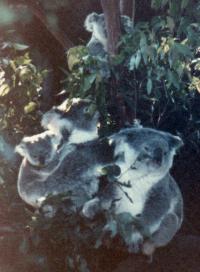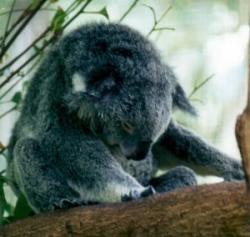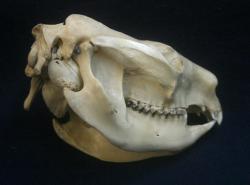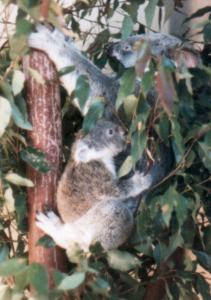
THE KOALA
SUPER COHORT MARSUPIALIA
COHORT AUSTRALIDELPHIA
ORDER DIPROTODONTIA
FAMILY PHASCOLARCTIDAE
| The koala, (Phascolarctus cinereus), is the
only extant member
of this family. Koalas live in Eastern Australia, where they mainly inhabit
eucalypt forests but they are also found in a range of habitats: montane
forests in the south, vine thickets in the tropical north and woodland
in the semiarid western regions.
Their dense woolly fur insulates their characteristic bearlike and tailless bodies. The colour and pattern of their coats differ so individual animals are relatively easy to identify. Koalas can live for up to ten years in the wild and twenty years in captivity. Koalas climb by gripping onto the smooth trunks and branches of eucalypt trees with their strongly recurved foreclaws, heaving themselves up with their powerful fore-arms and bringing up their hind quarters in a bounding motion. The opposable first and second digits on their hands enable them to grip twigs and pick leaves. Koalas walk slowly on the ground on all fours. |  |
 | The koala is the largest of the
Australian arboreal browsers, weighing 6.5 - 12 .5 kg. It eats about
500 g of leaves a day
but only feeds on 30 of the 600 species of eucalypt found in Australia.
This food is low in energy and short in essential nutrients, like
nitrogen and phosphorus, which forces koalas to move slowly to
conserve energy and to enjoy a particularly inactive life style. Koalas
sleep for 80% of the day,
just sit for 10% and feed for 10%. Their small brains are probably another
adaptation to their low energy diet, for brains are expensive in terms of
energy costs.
Eucalypt leaves are poisonous for most animals, but the koala's liver detoxifies some toxins so they can be excreted. The leaves are digested by microbial fermentation in the caecum. The low protein value of the leaves means they take a long time to digest and the koala's caecun is about four times the length of its body. Koalas rarely drink as they get most of their moisture from the leaves they eat; they also conserve water by reducing the amount expelled in the urine. |
 | Koala skull: Dental formula I3/1; I1/0; PM 1/1; M 4/4. |
The koala has a space or diastema between its incisors and premolars in which to store leaves before they are processed by the premolar and four broad, highly cusped molars on its upper and lower jaws. These teeth grind the eucalypt leaves into a paste making it easier for the food to be digested by the microbial fauna.
Koalas are solitary animals only coming together to breed. Males and females become sexually mature at 2 years of age. The females are seasonally polyoestrous and breed once a year. The gestation period is about 35 days. Koalas usually have one offspring, which remains in the mother's pouch for 5-7 months after which it is carried on the mother's back. Towards the end of its life in the pouch, the cub feeds on material passed through the mother's digestive tract rather than milk and so obtains the microbes it needs to digest eucalypt leaves. The cub remains with the mother for up to 12 months when it goes away to fend for itself. Koalas need large home ranges due to the females need for food for the young. |  Female with young |
The koala's habitat is being destroyed in many places to make way for agriculture and logging, and because koalas do not migrate, once their habitat is gone they cannot survive. Koalas are now a protected species in Australia.
| Bandicoots | Dasyurids | Marsupial moles |
| Thylacine | Wombats | |
| Kangaroos | Possums | Feathertail or pygmy glider |






